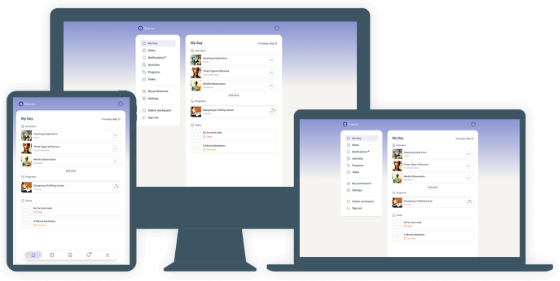In literature, a care pathway is “a complex intervention for the mutual decision-making and organization of care processes for a well-defined group of patients during a well-defined period.”[1]
A care pathway is a comprehensive and integrated plan for patient care, meaning it covers patient care from beginning to end.
A good care pathway includes:
- An explicit statement of the goals and key elements of care
- Facilitation of communication among team members and with patients and their families
- Coordination of roles and sequencing of activities of the multidisciplinary care team, the patients, and their families
- Documentation, monitoring, and evaluation of outcomes
- Identification of appropriate resources[2]
You could say that care pathways define what happens, when it happens, and who does what regarding diagnosis, treatment, and follow-up for health care.
So we know what a care pathway is, but why does it matter?
Purpose of The Care Pathway Approach
According to Richard Rosique, a senior consultant for hospitals and medical groups, a care pathway is “one of the best tools hospitals can use to manage the quality in healthcare…”[3]
When hospitals see large numbers of patients with similar symptoms and issues who need specific types of care or interventions, it makes good sense to “bundle” their care into pathways. This way, healthcare providers can use the predictability of this process to their advantage, defining and optimizing treatment plans and ensuring patients get the most effective, most efficient care.
This is easy to understand for hospitals, but what about care pathways in mental healthcare? Do they still apply?
What is a Care Pathway in Mental Healthcare?
Care pathways in mental healthcare are a little different. Instead of coordinating care in a hospital setting and coordinating disparate specialties into one big team, the focus is more on mental health care.
However, that’s not to say that the team isn’t multidisciplinary; a good team will include administrators, care navigators, physicians or other healthcare professionals, and mental healthcare providers like therapists, counselors, and psychologists.
Like care pathways used in hospitals, care pathways in mental health inform care providers, patients, and their families of what to expect along the treatment journey—they just focus on mental health diagnosis, treatment, and follow-up. For example, care pathways in mental health are modeled around depression, anxiety, and substance abuse rather than rheumatoid arthritis, appendicitis, or diabetes.
It defines what patients are being seen for (e.g., symptoms of depression), what assessment or diagnosis tools should be used (e.g., the Patient Health Questionnaire), who administers or participates in which steps (e.g., nurse, intake counselor, psychiatrist), and what referrals, treatment plans, or next steps are appropriate in which situations (e.g., a crisis center for suicidal thoughts, a therapist for mild-to-moderate depression, a psychiatrist if medication may be helpful).
2 Examples of Integrated Care Pathways
Care pathways are easier to understand when made visual, so let’s look at some examples.
This example comes from Dr. Jeff Capobianco’s presentation on care pathways in mental health.[4]
As you can see, this example is more detailed and includes more specific instructions for contingencies like whether the patient has a primary care provider or not or if the provider is unsure about whether the patient is suicidal or not. It also specifies which numbers should be provided for different paths.

What Is the Best Care Pathway Management Tool?
Several tools and solutions can plot care pathways, from the very basic spreadsheets and flowcharts to the tools designed to create care pathways. The right tool for you will depend on what features you need and the budget you’re working with, but your options include:
- Using a spreadsheet tool (e.g., Excel or Google Spreadsheets) to create flow charts
- Software/tools intended for diagraming and creating flowcharts (e.g., LucidChart, Microsoft Visio)
- Software/tools intended for creating care pathways (e.g., Quenza)
Spreadsheet tools are generally the cheapest options, as most computers and mobile devices come equipped with spreadsheet tools like Microsoft Excel, and Google Spreadsheets is an easy-to-use free option. However, they require some finesse to use for this purpose. Creating diagrams and flow charts using basic spreadsheet tools takes time, effort, and skill.
The software and tools that are intended for diagraming and creating flow charts are a more targeted option, offering more features and a more user-friendly interface to create the complex visual representations that you need for creating care pathways. However, they are typically better for people documenting standardized procedures, and you may have trouble incorporating all the elements you need to visualize an effective care pathway. They are also generally not free, although most are fairly low-cost.
The best option is going to be something designed with creating care pathways in mind, like Quenza.
Crafting Care Pathways with Quenza’s Templates

Quenza was made to create straightforward, unique, and customizable care pathways for you and your clients. With Quenza’s easy-to-use drag-and-drop tool, you can assemble a pathway with assessments, questions, exercises, and research-backed and evidence-based resources.
For example, a mental health care provider may want to put together a care pathway for clients who are struggling with depression. This care pathway might include the initial assessment, information and resources on treating depression, activities and techniques the client can use independently, and follow-up assessments.
With Quenza’s templates, you can create pathways that provide the right tools at the right time. Resources can be shared with clients as needed or on your customized timeline.
Not only will Quenza’s care pathways help you stay organized and keep clients on the right track, they will also serve to keep your clients engaged in their own treatment plan, which increases the odds of success.
Technology’s Role in Enhancing Care Pathways
Technology integration in healthcare has revolutionized how care pathways are managed and implemented. Advanced software solutions and digital tools facilitate the efficient design, execution, and monitoring of care pathways, ensuring patients receive coordinated and timely care.
Electronic Health Records (EHRs) play a pivotal role in this process by providing healthcare professionals with real-time access to patient data, enabling better decision-making and streamlined communication across different care providers. Moreover, telemedicine and mobile health applications have made it possible to deliver personalized care remotely, improving access to healthcare services for patients in rural or underserved areas.
Data analytics and AI can also predict patient outcomes and identify potential issues before they arise, allowing for proactive patient care management. By leveraging these technologies, healthcare organizations can enhance the effectiveness of care pathways, ultimately leading to improved patient outcomes and satisfaction.
Challenges and Future Directions in Care Pathway Implementation
While care pathways have significant benefits, their implementation is not without challenges. One of the primary hurdles is ensuring consistency and adherence across different healthcare providers and settings. Variability in care delivery can lead to discrepancies in patient outcomes, undermining the care pathway’s efficacy.
Additionally, integrating new technologies and systems requires significant investment and training, which can be a barrier for some healthcare organizations. Data privacy and security are also challenged, especially with the increasing reliance on digital tools and electronic records.
Despite these challenges, the future of care pathways looks promising. Ongoing advancements in healthcare technology, coupled with a growing emphasis on patient-centered care, will likely drive further innovation in this field. Collaborative efforts between healthcare providers, policymakers, and technology developers are essential to address these challenges and develop robust, scalable solutions that enhance the implementation and effectiveness of care pathways.
Leveraging Technology in Care Pathway Management
Integrating advanced technology into care pathway management can significantly improve efficiency and patient outcomes. Electronic Health Records (EHRs) are a prime example, offering a centralized system to store, access, and update patient information seamlessly. EHRs enhance communication among healthcare providers, ensuring all team members have access to the latest patient data, which is critical for coordinated care.
Telehealth is another technological advancement revolutionizing care pathways. It allows patients to consult with healthcare providers remotely, reducing the need for physical visits and increasing accessibility. This particularly benefits patients in remote areas or those with mobility issues. Telehealth also enables continuous monitoring of chronic conditions, allowing for timely interventions and adjustments to care plans.
Artificial Intelligence (AI) and machine learning also make significant strides in care pathway management. These technologies can analyze vast amounts of patient data to identify patterns and predict outcomes, helping healthcare providers to make informed decisions. AI can also assist in personalized care planning, ensuring patients receive tailored treatment based on their unique needs and medical history.
Moreover, mobile health applications are becoming invaluable tools for patient engagement. These apps can remind patients to take their medications, attend appointments, and perform necessary health checks. They also provide educational resources and support, empowering patients to participate in their health management actively. By leveraging these technologies, healthcare providers can enhance care pathways’ efficiency, effectiveness, and patient-centeredness.
The Role of Interdisciplinary Teams in Care Pathways
Interdisciplinary teams are essential in the effective management of care pathways. These teams bring together healthcare professionals from various disciplines to collaborate on patient care. This approach ensures that all aspects of a patient’s health are considered, leading to more comprehensive and holistic care plans.
Effective communication is the cornerstone of successful interdisciplinary teams. Regular meetings and shared documentation allow team members to stay informed about each patient’s progress and any changes in their condition. This communication ensures that care is coordinated and all team members work towards the same goals, reducing the risk of errors and duplicative efforts.
Each member of an interdisciplinary team brings a unique perspective and expertise. For example, doctors provide medical oversight, nurses manage day-to-day patient care, physical therapists address mobility issues, and social workers support the patient’s emotional and social needs. This diversity of expertise ensures that all aspects of patient care are addressed, leading to better health outcomes.
Interdisciplinary teams also enhance patient engagement. When patients see that their care is managed by a cohesive team, they are more likely to feel supported and confident in their treatment plan. This trust can lead to better adherence to care plans and a more proactive approach to health management. By utilizing interdisciplinary teams, healthcare providers can ensure that care pathways are comprehensive and patient-centered.
Final Thoughts
If your work regularly includes clients that are on the same general care “path,” you’ll want a tool that can help you create and use customized care pathways. You have several options, but your best bet is a tool that’s made for this purpose, like Quenza.
Check out all that Quenza can do and see if it’s the right platform for your practice.
References
- ^ Vanhaecht, K., De Witte, K., & Sermeus, W. (2007). The impact of clinical pathways on the organization of care processes. (Doctoral dissertation). Retrieved from https://lirias.kuleuven.be/1718750
- ^ Schrijvers, G., van Hoorn, A., & Huiskes, N. (2012). The care pathway: Concepts and Theories: An introduction. International Journal of Integrated Care. Retrieved from https://dx.doi.org/10.5334/ijic.812
- ^ Rosique, R. (n.d.). Care pathways: The basics. Asian Hospital & Healthcare Management. Retrieved from https://www.asianhhm.com/healthcare-management/care-pathways-basics/
- ^ Hoffman, R., & Pezor, L. (n.d.). Behavioral health: An integrated care pathway of the collaborative care network. Anne Arundel Medical Center.



